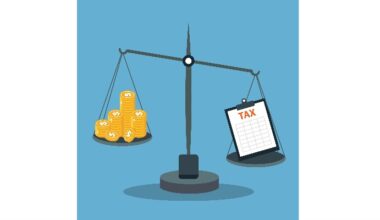If you have a savings account, the annual percentage yield will be of great importance to you. Why? The higher the annual percentage yield (or APY), the more money you make. We’ll explain how you can calculate the annual percentage yield in this chapter. But first, let’s define the APY.
Definition Of The Annual Percentage Yield
The annual percentage yield, abbreviated APY, is the rate earned on an investment over a year, taking into account the effects of compounding interest. The following formula is used to calculate the annual percentage yield:
APY = (1 + r/n) n-1
Here, “r” represents the stated annual interest rate, and “n” represents the number of compounding periods per year. The effective annual rate, or EAR, is another name for APY.
Conversely, you can calculate the Annual Percentage Yield using this percentage calculator app.
Understanding The Annual Percentage Yield
When the APY equals the interest rate paid on a person’s investment, he is earning simple interest. When the APY is greater than the interest rate, the interest is compounded. This simply means he is receiving interest on his interest.
People frequently mix up APY with APR. The annual interest rate without compounding interest is referred to as the APR. APY, on the other hand, takes into account the impact of compounding within a year. The distinction between the two can have serious consequences for borrowers and investors.
When banks or other financial institutions seek clients for interest-bearing assets such as money market accounts and certificates of deposit, it is in their best interests to promote their best APY rather than their APR. Because APY is greater than APR, it appears to be a superior investment for the client.
The higher the APY, the more frequent the compounding periods. As a result, those who save money in bank accounts should consider how frequently the money is compounded. Generally, daily or quarterly compounding is preferable to annual compounding, but check the quoted APY for each choice first.
Example of APY
If a person deposits $1,000 in a savings account with an annual percentage yield of 5%, he will receive $1,050 at the end of the year.
However, the bank may calculate and pay interest every month, in which case he would conclude the year with $1,051.16. In the latter situation, he would have earned an annual percentage yield of more than 5%. The difference may not be dramatic at first, but it becomes considerable over a few years (or with greater investments). In this case, we calculate the annual percentage yield as follows:
(1+0.5/12)12-1= 5.116% annual percentage yield
The annual percentage yield (APY) can show investors exactly how much interest they will receive. They can compare options using this knowledge. They will be able to choose the best bank and whether or not they want to pay a higher interest rate.
How to Calculate the Annual Percentage Yield
If you know your account’s interest rate, you can manually calculate the annual percentage yield using the following formula:
(1 + r/n)n – 1 = APY
In which case:
r denotes the interest rate.
n denotes the number of compounding periods (if interest is compounded monthly, this would be 12)
Your APY could also be provided by your bank or credit union.
What Is Compound Interest?
Compounding happens on a regular basis, frequently daily or monthly. Interest compounded daily is more profitable than interest compounded monthly.
However, unless you’re dealing with enormous amounts, it’s often too minor to be concerned about – and even then, it won’t make a substantial difference. For example, $100,000 in a 0.50 percent APY account earns only $0.10 more in a year when compounded daily rather than monthly.
Finding a high annual percentage yield should be a top goal when looking for a new savings account or CD. The higher the interest rate, the faster your money will increase.
Is Apy Subject to Change?
This is determined by the savings product. If you have a savings account, your annual percentage yield is variable and can rise or fall depending on market circumstances. If you have a CD, the rate you get when you sign up is usually the rate you’ll get for the duration of your term. However, if you sign up for another CD later, you can get a different rate.
When the Federal Reserve raises its key interest rate, APYs on savings accounts and new CDs tend to rise in tandem. When the Fed lowers its target rate, as it did twice in March 2020, APYs tend to fall.
Regardless of the benchmark rate, online banks often offer the best available APYs – while these institutions tend to lower their APYs when rates are low, they also increase them when rates are high.
The important thing to remember is that because internet banks offer the highest savings account rates, they can help you grow your money faster than traditional brick-and-mortar banks.
The Significance Of The Annual Percentage Yield
Any investment, whether a certificate of deposit (CD), a piece of stock, or a government bond, is ultimately measured by its rate of return. The rate of return is essentially the percentage of growth in an investment over a given time period, which is often one year. However, comparing rates of return across different assets might be problematic if they have different compounding periods. One may compound on a daily basis, whilst another may compound regularly or biannually.
Comparing rates of return by merely expressing the percentage value of each over one-year yields an erroneous answer because compounding interest is ignored. It is crucial to understand how frequently that compounding occurs, because the more frequently a deposit multiplies, the faster the investment grows. This is because the interest generated over that period is added to the principal balance each time it compounds, and future interest payments are computed on that greater main amount.
When advertising interest-bearing accounts in the United States, banks are required to include the APY. This tells potential consumers just how much money a deposit will generate over the course of a year.
APY vs APR
APY is similar to the annual percentage rate (APR) used for loans. The APR represents the effective percentage that the borrower will pay in interest and fees for the loan over the course of a year. Both APY and APR are standardized interest rate metrics given as an annualized percentage rate.
However, APY considers compound interest, but APR does not. Furthermore, the APY equation does not include account fees, only compounding periods. This is a crucial factor for an investor, who must weigh any fees that will be deducted from the overall return on investment.
APR vs. APY: Interest Rates
Compound interest can be a very effective strategy for increasing wealth. When interest compounds, you essentially earn interest on your interest, and the longer you invest and save, the more potential your money has to grow.
APR (annual percentage rate) and APY (annual percentage yield) are two terms that are widely used to describe the interest rate paid on a savings account, loan, money market account, or certificate of deposit. The names don’t make it apparent how the two terms—and the interest rates they describe—differ.
Understanding what APR and APY are and how they are calculated will help you understand how hard your money is working for you.
It’s All About Compounding
APR and APY are relatively straightforward words to define. The APY, in the context of savings accounts, represents the annual interest rate paid on an investment. APR refers to the annualized interest rate you pay on credit cards, loans, and other debts in the context of borrowing. It covers both the interest rate on the loan and any fees charged by the lender.
The main distinction between APR and APY is how they relate to your savings, investment growth, or borrowing costs.
When it comes to savings or investments, APY takes into account how frequently interest is applied to the balance, which can range from daily to annually. Simply put, the more frequently your interest rate compounds, the faster your money grows. APR does not function in the same way.
How Compounding Works
Here’s an illustration of how compounding works. Assume you put $10,000 into an online savings account with a 5% APR. If interest is only applied once a year, you will have earned $500 after one year.
Assume, on the other hand, that interest is applied to your balance on a monthly basis. This means that the 5% APR would be divided into 12 smaller monthly interest payments.
In this situation, the interest rate would be around 0.42 percent every month. After the first month, your $10,000 deposit would earn $42 in interest using this strategy. That is, 0.42 percent would be applied to the new balance of $10,042 in the second month, and so on.
In this example, even though the APR is 5%, if interest is compounded once a month, you would see about $512 in earned interest after one year. That means the annual percentage yield (APY) is roughly 5.12 percent. And this is the real amount of interest you’ll earn if you keep the investment for a year.
Of course, if you’re thinking about investing in something where interest is only applied to the balance once a year, your APR will be the same as your APY. This is not a regular scenario, and you are unlikely to come across it at your bank.
Banks Primarily Promote Apy for Savers
When banks are looking for consumers for interest-bearing investments like certificates of deposit or money market accounts, it is in their best interest to advertise their best annual percentage yield rather than their best annual percentage rate.
The reason for this is self-evident: the annual percentage yield is higher, making it appear to be a superior investment for the consumer. Finding a high APY should be a priority, since the higher the APY, the more potential for compounding your money.
In a borrowing scenario, on the other hand, APR would be the inverse. You want the APR on a vehicle loan, mortgage, credit card, or any other sort of finance to be as low as feasible. The lower the APR, the less interest you’ll pay throughout the life of the loan or line of credit.
Also, keep in mind that APRs, which are linked to borrowing, can be variable or fixed. A variable rate can rise and fall in parallel with variations in the index rate to which it is linked. A fixed APR, on the other hand, would remain constant throughout the repayment term. Thus, allowing you to predict your monthly payments and total interest paid. This is especially crucial for long-term loans, such as mortgages, which typically last 30 years. Fixed-rate mortgages pose less risk to borrowers than variable or adjustable-rate mortgages (ARMs).
How Is APY Determined?
The annual percentage yield (APY) standardizes the rate of return. This is accomplished by indicating the real percentage of growth that will be gained in compound interest if the money is deposited for a year. The formula to calculate annual interest percentage is (1+r/n)n – 1, where r is the period rate and n is the number of compounding periods.
How Can an APY Help an Investor?
Any investment, whether a certificate of deposit, a piece of stock, or a government bond, is eventually measured by its rate of return. APY allows an investor to make a more educated selection by comparing different returns for different assets on an apples-to-apples basis.
Do you want high or low APY?
Your potential return on investment (APY) is proportional to the rate at which your money is invested. However, keep in mind that your earning potential is inversely proportional to the amount of cash you currently possess. The APY considers both the interest rate and the frequency with which interest is compounded to arrive at a final figure.
Is a APY of 1% good?
Although some checking accounts offer interest rates of over 1% APY, the vast majority offer only a negligible or even negative return on deposits. The typical annual percentage yield (APY) for a savings account is only 0.1%; however, the top savings accounts offer returns of at least 1% APY.
Can you make money on APY?
The annual percentage yield (APY) is a measure of the interest rate on a deposit account. Deposit accounts like savings accounts, CDs, and money markets are common places for consumers to earn APY.
What is the highest APY right now?
As of 2023, the highest annual percentage yield you can get on a savings account anywhere in the country is 4.10%. (APY). Compare that to the national average for savings accounts, which is currently at 0.24% APY, as reported by the FDIC, and you’ll see that this is just one of the top rates available in our rankings below.
Why is my APY so low?
Financial institutions make a profit when the interest rate on the money they lend out is higher than the rate they pay people who deposit money into savings accounts, which is one reason why savings account rates are so low. When interest rates on loans are low, financial institutions often maintain even lower interest rates on savings accounts to maintain revenue.
Who is not eligible for APY?
Workers in the informal economy who cannot afford a pension plan are eligible for APY, a government-run social security pension scheme that was introduced around seven years ago.
In Conclusion,
The APY determines the amount of interest you earn on your savings account. Therefore, knowing how to calculate the annual percentage yield will give you an insight into what to look out for when opening a savings account.
Frequently Asked Questions
Is annual percentage yield a good thing?
The annual percentage yield is good because the higher it is, the faster your money grows.
What bank has the highest APY?
According to Nerdwallet, the bank with the highest APY is Bread Savings.
Can I live off interest on a million dollars?
Investing a million dollars in the stock market will earn you $96,352 in interest over the course of a year. And this is enough interest to live on.
Related Articles
- SHARE CERTIFICATE: Overview, Templates, Rates, Formats(+Quick Tool)
- FREE BUSINESS CHECKING ACCOUNT: Best 15+2023 option & how –to-open guide
- Present Value Formula: Definitions, Examples, Formula & Calculations
- BUSINESS DEPOSIT ACCOUNTS: List of the Best Deposit Accounts in 2023 (Updated)
- FINANCE CHARGE: What Exactly Are Finance Charges? Why Are They Important?






